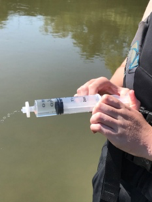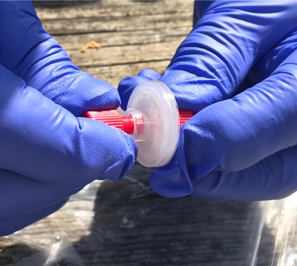Survey of the Little Miami and River Corridor (SOLMARC)
- Mary Ward Kuramoto
- Jul 9, 2023
- 4 min read
Little Miami State and National Scenic River Features Fish, Fatmuckets, and Fun

The Little Miami Conservancy (LMC) is continuing SOLMARC - a two year project encompassing a year-long volunteer initiative to survey the Little Miami State and National Scenic River along its corridor from the Little Miami’s origin at John Bryan State Park to the Ohio River Confluence.
SOLMARC’s goal is to search for and document all aspects of the Little Miami River that deserve attention in terms of ecologic improvement. By doing so the Little Miami Conservancy wants to focus on conditions and opportunities for volunteer stewardship to better support and improve an already outstanding 100-mile plus State and National Scenic River in Ohio. One of the many ways the Little Miami Conservancy shares its environmental message is by partnering with other local organizations to leverage volunteer hours and share the wonder of the Little Miami State and National Scenic River through interpretive river floats.
A Beautiful Day for a River Float
Once such instance was a recent float utilizing a float trip for two on the Little Miami State and National Scenic River. The float trip was donation by LMC to support Buckeye United Fly Fishers Inc. (BUFF) a non-profit committed to promoting the sport of family fishing through education and conservation. The float trip, was used by three passionate outdoors men to fulfill a portion of the SOLMARC Project by observing wildlife, in and out of the water, on a section of the river named “Blue Jacket’s Best,” just north of Waynesville, OH. This section of the Little Miami is 3 ½ miles long from Constitution Park Public Access near Spring Valley to Rivers Edge Outfitters, a local canoe/kayak livery for that section of the river.
The Little Miami Conservancy used an LMC inflatable guide boat holding three volunteers, with the oarsman – Bill Schroeder - rowing from the middle seat and fishermen - Jack Gormley and Charley Nash- in high back swivel seats fore and aft. A perfect trio to enjoy an afternoon fishing and observing and documenting the Little Miami River’s current condition.
Of Mussels and Men
After rowing about ¼ mile upstream against the current, the crew beached the boat to fish, and discovered freshwater mussel shells strewn across a gravel bar there. They took pictures of several mussel shells and were able to identify several species – Plain Pocketbook (Lampsilis cardium), Fatmucket (Lampsilis siliquoidea), and Threeridge (Amblema plicata).

According to the Ohio ODNR Wildlife Division’s Field Manual on Freshwater Mussels, the Fatmucket (Lampsilis siliquoidea) is the second most common species of freshwater mussels in Ohio. That said, all native mussels are declining in both numbers and species.
The freshwater mussels deserve special protection, playing an important role, helping keep stream waters clean and healthy by straining and removing impurities from the water.
What’s in the Water Anyway? The Science of eDNA.
One SOLMARC objective is to understand the variety of aquatic species calling the Little Miami State and National Scenic River home. While this can be a visual observation, the use of eDNA has enabled citizen scientists to conduct eDNA testing.
Cutting-edge environmental DNA (eDNA) stream water sampling at sites along the Little Miami make it possible to process and sequence eDNA using environmental laboratories. Using eDNA makes it possible to determine and document most species of fish in the Little Miami without capturing, disturbing or harming them in any way. Most importantly, the diversity of all fish species and potential host fish can be determined without every seeing or touching them.
Jack, Bill, and Charlie conducted some eDNA testing along their route. The trio collected environmental eDNA water samples to submit for lab analysis to help detect and identify diverse fish species, an important task associated with the SOLMARC initiative.
Now for the Fishing!

The float team proceeded downstream, fly fishing along the way, to determine what fish species might be caught, identified, and safely released. The fishing was fun, but tough due to cloudy brownish colored water stained from recent rains. The group didn’t catch many; a couple of smallmouth bass and one rock bass. But there was so much more to enjoy.
Red-tail Hawks along the Little Miami
A mile or so downstream, they drifted past a red-tailed hawk, sitting on a large fallen tree along the right descending bank. Apparently thanks to its excellent camouflage coloring, they didn’t notice it was until the boat had drifted to within about to within 10 feet of the downed tree where it was perched. The hawk must have seen the group, and suddenly but silently flew away.
Red-tailed hawks are large birds of prey found in Ohio and throughout the United States. Their role in the ecosystem is important and their habitats are threatened, so they are protected under several U.S. laws. The most significant of these laws, the federal Migratory Bird Treaty Act of 1918, provides protection to numerous other species of birds. These include eagles, egrets, great blue herons and more. The red-tailed hawk is not presently classified as endangered or threatened.

Most Red-tailed Hawks are rich brown above and pale below, with a streaked belly and, on the wing underside, a dark bar between shoulder and breast. The tail is usually pale below and cinnamon-red above, though in young birds it's brown and banded.
Survey Of Little Miami River and Corridor (SOLMARC) Project Continues
LMC will continue to use other outdoor float programs to gather information to help support programs, events and activities like these all summer long. Among its interpretive activities and events, Little Miami Conservancy partners with other non- profits, like Buckeye United Fly Fishers, the Izaak Walton League, local schools, and Adventure Crew.
For more information about SOLMARC,
and to learn how you can participate as
a volunteer, contact Bill Schroeder by
email at bschroeder9999@gmail.com
.jpeg)





Comments